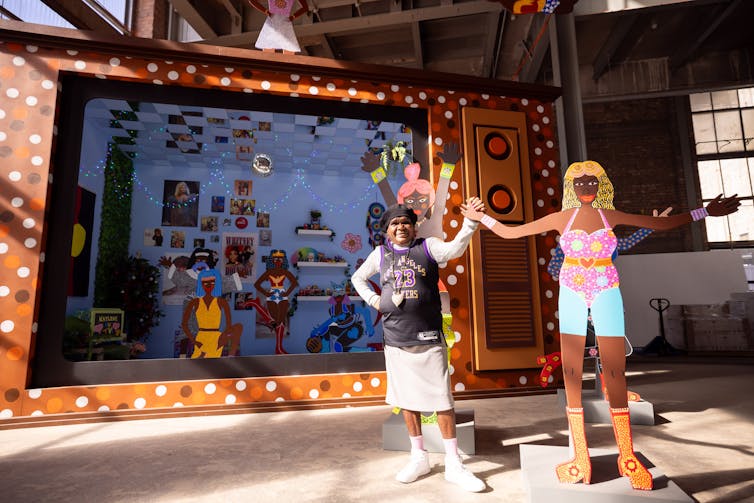Sydney Biennale invites us to celebrate our collective resistance in dark times
- Written by Christiane Keys-Statham, PhD Candidate, Institute for Culture and Society, Western Sydney University

The 24th edition of the Biennale of Sydney, titled Ten Thousand Suns, is an explosion of joy and creative energy across seven venues, including the sails of the Opera House and White Bay Power Station.
This iteration, led by co-artistic directors Inti Guerrero and Cosmin Costinas, includes the work of 96 artists from 45 countries. Guerrero and Costinas proposed an overarching theme of “celebration” for this edition: celebration not only as an event or social practice, but a method of creative and collective resistance in dark times.
Read more: Explainer: what is a biennale?
The post-industrial sublime
The debut of White Bay Power Station as the Biennale’s new venue and a site for ongoing cultural production is certainly worth celebrating. The Biennale is the first test event at White Bay, Sydney’s newest arts and culture precinct.
The imposing internal spaces provide space for ambitious, celebratory and experiential works. There is Dylan Mooney’s portrait of dancer and activist Malcolm Cole dressed as Captain Cook for Mardi Gras in 1988, and Kaylene Whiskey’s Kaylene TV, an interactive work in the form of a giant television set.
The building’s history as a site of extractive industries is addressed in some works, such as Monira Al Qadiri’s video work, Crude Eye.
Others connect more closely to the curatorial themes of resistance, cultural hybridity and joy, like Andrew Thomas Huang’s suspended sculpture, The Beast of Jade Mountain: Queen Mother of the West, a powerful depiction of the Chinese deity Xiwangmu.
The challenge for artworks displayed in sites such as White Bay is in the dialogue with the architecture itself. Here, artworks must compete with the visual impact of these spaces and their heritage machinery. This produces an overwhelming sense of the post-industrial sublime: a feeling of awe experienced in the huge and now-defunct “cathedrals of power”.
Curators working in post-industrial spaces often deal with this issue by programming large-scale, immersive installations or works responding directly to the building’s architecture.
Darrell Sibosabo’s Galalen at Gumiri is an illuminated reframing of traditional riji (pearl shell) designs from Bard Country in Western Australia. These shells have been ceremonially carved and worn for thousands of years. Through his large-scale light works, Sibosabo reiterates Aboriginal culture is alive, pulsing with energy and adaptive to change.
This work simultaneously responds to the building’s scale and connects to the curatorial premise of celebrating cultural practices maintained and reimagined by artists around the world.
Conversations across works and venues
Celebrating multiple perspectives and worldviews, the curators’ expanded notion of art encompasses works by unknown makers, such as the delicate work on amate (tree bark) paper by unrecorded Mexican artists, on display at UNSW Galleries.
The artists have used traditional paper-making practices originating in Mayan and Aztec cultures, banned by Spanish colonisers. This practice continued in secret among at Indigenous communities such as the Otomi, who now create these depictions of cut-out spirits for a commercial market.
Resilience is felt clearly in these works, dissolving the boundaries between collection items collected or stolen as part of colonial museum practices, and artworks continuing cultural practices.
Sibosabo’s work engages across venues in dialogue with the pearl shell collection items at Chau Chak Wing Museum, highlighting the unbroken connections between contemporary art and traditional Indigenous practices.
Also at Chau Chak Wing are enduring celebrations of queer communities and their resistance. Martin Wong’s enigmatic and dreamy visions of urban erotica and William Yang’s candid photographs of young Indigenous dancers celebrate the survival of queer creativity and strength.
Feminist world-making is a joyful focus across multiple venues. VNS Matrix at White Bay celebrate their anarchic, collective and anti-capitalist practice. Kubra Khademi at UNSW Galleries creates a feminist universe that refutes the patriarchal order with humour and subversion. Serwah Attafuah at the Museum of Contemporary Art draws us into a surreal cyberscape, extending the curatorial themes of celebration and resistance into the future.
Joy and imagination
The risk in curating so many works in one show, under such a broad theme, is that individual artworks can be contorted to fit within a generalised framework.
The Biennale falls into this trap at times, particularly in venues such as the Art Gallery of New South Wales, where the sheer amount of artwork on display makes viewing challenging and the curation occasionally feel heavy-handed and didactic.
Another issue is the de-politicisation of individual works, which, when placed together with artworks from other parts of the world, can lose their contextual power of protest. Individual issues and social injustices can become neutralised as they are combined under one broad theme.
There is occasionally a failure to acknowledge the complexity of artistic responses to trauma and the violent interruption of cultural practices. However, the fact that we are now facing a dark future – with climate chaos well underway and colonialism carrying on in many parts of the world – means we are desperately in need of inspiration and continuing hope.
The artists of the Sydney Biennale provide many strategies for communal strength, joy and imagination to carry us through the dark times ahead, and audiences are sure to join the carnival.
Correction: this article originally misstated the name of Darrell Sibosabo’s artwork. It is Galalen at Gumiri.
Authors: Christiane Keys-Statham, PhD Candidate, Institute for Culture and Society, Western Sydney University



